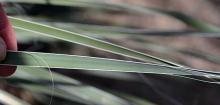Yucca elata
Common name:
Soaptree Yuca
Pronunciation:
YUK-ah el-AH-tuh
Family:
Asparagaceae, Agavaceae, Liliaceae
Genus:
Synonyms:
Yucca elata var. elata
Type:
Broadleaf
Native to (or naturalized in) Oregon:
No
-
Broadleaf, evergreen shrub or small tree, with a sporadically branched trunk, very slow growing, about 1 inch (2.5 cm) per year, but it may reach a height of 4 to 15 ft (1.2 to 4.5m). It is considered very ornamental. Leaves are collected in a dense spiral whorl at the top of stems, each leaf is 25-95 cm long but narrow, only 0.2-1.3 cm across. Flowers are borne in a dense cluster at top a slender stem that is 4-6 ft (1.2-1.8 m) tall, each flower is 3-6 cm long, creamy white, often tinged pink or green. The fruit is 4-8 cm long and 2-4 cm wide; when it matures in summer it is brown and splits into three sections releasing black seeds.
- Sun, dry, well-drained soil
- Like all yucca species with dehiscent fruits, soaptree yucca is rhizomatous. The species is unique in that the rhizome develops downward (to 3-5 feet [1-1.5 m] deep) and later begins lateral root extensions (U.S Forest Service).
- Hardy to USDA Zone 7 Native range from west Texas to central New Mexico and central Arizona and northern Mexico; also found in small areas of southeast Nevade, southwest Utah, and northwest Arizona. Yucca elata var. verdiensis (Verdi yucca) is a shorter form found in central Arizona, most commonly in regions of the Verde River and it's tributaries.






